Discovering DMR – 1
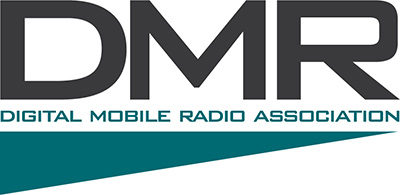
Revised: Jun 2023; CC BY-SA![]()
As of Jan 1, 2024, this site is no longer being updated. It will remain available for some time for legacy reference.
Most up-to-date version: amateurradionotes.com/dmr.htm
Disclaimer: These are my personal notes and opinions based on my experience using DMR, as well as by learning from what others are sharing. I pay for all my equipment and do not accept freebies in exchange for reviews. If anything needs correcting, please let me know![]() .
.
Why?
[ I wrote these two introductory paragraphs in 2016, shortly after learning how to use D-STAR. I've been updating the rest of the article regularly as I learn more.]
After weeks of intense learning and effort, I felt like I was just beginning to get a handle on D-STAR, having put together a nicely working solution for my shack as well as for mobile. So why did I decide to adventure off in a new direction already?
I guess I must be a bit crazy, but a learning opportunity presented itself, so I decided to dive right back into another bowl of baffling info-soup and learn how to swim all over again, this time in the DMR soup bowl. I ordered a DMR HT, and started this page to record my new adventure.
1) What is DMR?
Short answer
A commercial digital voice system that amateur radio enthusiasts are adapting for use by hams. More at Wikipedia![]() .
.
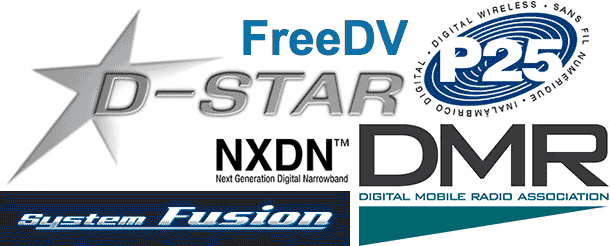
Other digital voice systems being developed or adapted for use by hams:
- D-STAR
 , an open standard developed for amateur radio by the Japan Amateur Radio League, with equipment by Icom and Kenwood.
, an open standard developed for amateur radio by the Japan Amateur Radio League, with equipment by Icom and Kenwood. - System Fusion
 , a proprietary system for amateur radio by Yaesu.
, a proprietary system for amateur radio by Yaesu. - P25
 , a standard developed for North American public safety services. Governed by the Telecommunications Industry Association and others.
, a standard developed for North American public safety services. Governed by the Telecommunications Industry Association and others. - NXDN
 , an open commercial and public safety standard initially developed by Icom (implemented as IDAS) and Kenwood (implemented as NEXEDGE), and now overseen by members of the NXDN Forum.
, an open commercial and public safety standard initially developed by Icom (implemented as IDAS) and Kenwood (implemented as NEXEDGE), and now overseen by members of the NXDN Forum.  There also are a couple open systems slowly being developed for amateur radio, which are based on an open source speech codec (vocoder) called Codec 2
There also are a couple open systems slowly being developed for amateur radio, which are based on an open source speech codec (vocoder) called Codec 2 . One is the M17 Project
. One is the M17 Project (more M17 info
(more M17 info ), and the other is called FreeDV
), and the other is called FreeDV . Thomas, W2XQ, has a good section of links to M17 resources⩘ on his site. For current info on the M17 and OpenHT projects: M17 Project on Mastodon
. Thomas, W2XQ, has a good section of links to M17 resources⩘ on his site. For current info on the M17 and OpenHT projects: M17 Project on Mastodon .
.
Longer answer
DMR is a digital radio standard originally designed for commercial use and developed by the European Telecommunications Standards Institute (ETSI) beginning in 2005, which hams now are adapting for amateur radio use.
If something about using DMR for Amateur Radio doesn't make sense, remember that DMR was created for commercial use, and was never designed nor intended for Amateur Radio use.
– Mike's DMR Doctrine, by Mike, K0NGA, of Rocky Mountain Ham Radio
And it's true, initially I did find it quite challenging to get up and running with DMR. It's different enough that I couldn't apply a lot of what I had just learned getting going with D-STAR. I had the additional challenge of needing to figure out how to get started via a personal, low-power hotspot, while most information available online was from the point of view of having access to a repeater.
Finally and thankfully, some Elmers with hotspot experience helped me put it all together and get on the air.
I also met Mike, K0NGA, in person at the 2017 Longmont Amateur Radio Club's LARCFest, and he graciously spent some time answering some questions I had and helping clarify a few points. He's a great guy; thanks for your help, Mike!
There's humor in them thar signals!
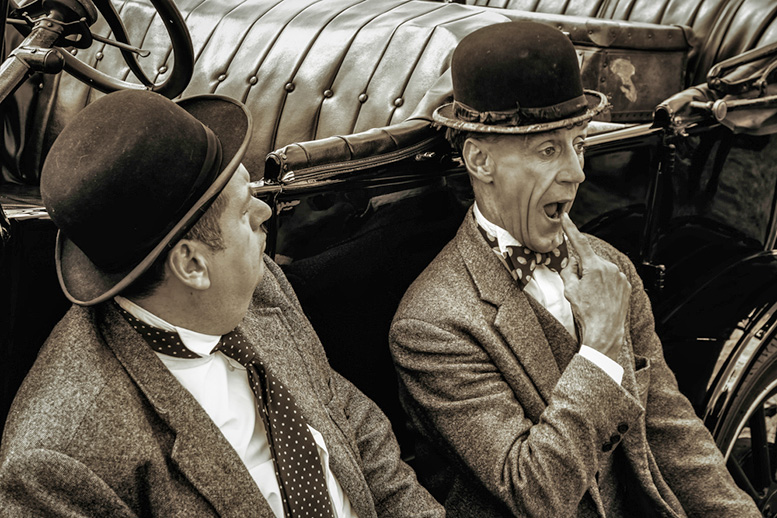
Laurel & Hardy lookalikes, Shoreham Airshow, 2014
Photo by Philip Bird LRPS CPAGB, Shutterstock![]()
I found it amusing that once I finally did get things working and then spent an evening listening to hams ragchewing on various talkgroups (I'll discuss those more later, but they're sort of like conference calls or chat rooms), a lot of the chatter was hams discussing questions about DMR like, "Why does it work that way?" and "How do I make it do this thing?" So I guess I'm not alone climbing the DMR learning curve.
In order to use DMR radios, in addition to using frequencies, channels, and repeaters/reflectors like you do with D-STAR, you also need to understand a bunch more puzzle pieces, and fit them together properly, including:
- 1a) Time slots
- 1b) Color codes
- 1c) Talkgroups
- 1d) Zones
- 1e) Rx group lists
- 1f) Scan groups
- 1g) DMR simplex frequencies
- 1h) DMR networks
And thar's a bit of frustration, too!
Whenever I found myself growling "Why isn't this working?!," it was helpful to keep Mike's DMR Doctrine in mind and take a step back to think about DMR in a commercial setting, like a big hospital, corporate campus, or casino. In an organization like that where there are many different departments using the radios (security, housekeeping, maintenance, catering, etc.), there typically will be a centralized IT team doing all the programming of all the locked-down radios they assign to members of the various departments.
DMR makes it relatively easy for the IT team to organize communications so that the members of each team can talk amongst themselves, as well as to control whether or not they have permission to talk with or monitor other teams, all within the closed ecosystem of their organization.
Of course, that's a very different scenario than an individual ham who wants to set up a radio for their own use in order to connect to open repeaters put up by amateur radio clubs that allow them to be used to connect to other hams or groups of hams locally, regionally, statewide, nationwide, or worldwide.
Adapting a complex system designed for the needs of a big organization within a closed ecosystem so that it can be used by hams in a more open worldwide ecosystem is a bit like trying to fit a simple square peg into a more complex hole in the shape of a 10-pointed star polygon.
And yet hams are figuring out how to make it work!
1a) Time slots
When there are so many puzzle pieces that need to be fitted together to set up a DMR radio successfully, it's challenging to figure out where to begin. It's a bit of a "Which comes first, the chicken or the egg?" problem, but I think a good place to start is with time slots, since they're fundamental.
If you read my Alphabetsoupese – example 2![]() note in the D-STAR article, you might recall that one way DMR differs from D-STAR is that it uses Time Division Multiple Access (TDMA
note in the D-STAR article, you might recall that one way DMR differs from D-STAR is that it uses Time Division Multiple Access (TDMA![]() ) to generate its signal instead of the Frequency Division Multiple Access (FDMA
) to generate its signal instead of the Frequency Division Multiple Access (FDMA![]() ) that D-STAR uses. Specifically, DMR uses 2-slot TDMA (the slots are numbered 1 and 2, or TS1 and TS2).
) that D-STAR uses. Specifically, DMR uses 2-slot TDMA (the slots are numbered 1 and 2, or TS1 and TS2).
If, like me, you're more fluent in English than Alphabetsoupese (a word I use to describe the crazy alphabet soup of acronyms that one encounters in the digital voice radio world), what this means is that calls on two different channels can share the same frequency simultaneously. Each call is sliced up into chunks of a few milliseconds, and the slices from the two calls are interleaved on the signal. This happens so fast that we hear what we perceive of as a continuous transmission even though it's coming in chunks, looking like this:

This also means that when you program a DMR channel, you must specify both the frequency and the time slot, so that your radio and the repeater can encode and decode which chunks on the signal belong to the channel you're using.
The convention is that TS2 is used for local talkgroups and TS1 is used for non-local or wide-area talkgroups (for example, statewide, regional, nationwide, and worldwide). I know, I know, here I am talking about talkgroups again before I've explained what they are, but I had to start somewhere!
1b) Color codes
Another fundamental piece of the puzzle is color codes (CC). They're like the Continuous Tone-Coded Squelch System (CTCSS) tones used for analog radio. When you want to use a DMR repeater, you need to program in the appropriate color code to open it up. There are 16 color codes, 0 – 15. Thanks to Nigel, G8IFF, for the following explanation of the reason they're called color codes:
[I]n the early days of DMR being a Motorola commercial system, the radio programming was done by Motorola who sold you a "plug" containing diodes that you plugged into a socket on the radio's circuit board. No user programming in those days. The color code was so called because it was indicated by a colored dot printed on the codeplug you were supplied with.
Just as with analog radio CTCSS tones, you need to get the appropriate color codes from the organization operating the repeater in order to be able to use the repeater. When you program a DMR channel, in addition to the frequency and the time slot, you must specify the color code; otherwise, you won't be able to access the repeater. So the magic formula to get onto a DMR repeater successfully = frequency + color code + time slot.
For example:
Frequency: 446.9875−
Color code: 7
Time slot: 1
will get you onto the wide-area time slot of the Lee Hill repeater located in Boulder, Colorado that is linked into the RMHAM (Rocky Mountain Ham) network.
Frequency: 445.075−
Color code: 1
Time slot: 2
will get you into onto the local time slot of the Pinery repeater located in Parker, Colorado that is linked into to BrandMeister network.
1c) Talkgroups & reflectors
Finally … let's talk about talkgroups (and reflectors)!
Of course, the whole point of getting onto a DMR repeater is to talk to other hams, and you do that by visiting a talkgroup, which enables one-to-many communication, sort of like a conference call or a chat room. The effect of using a talkgroup is similar to linking to a D-STAR reflector; anything transmitted to a talkgroup is transmitted to everyone listening to (linked to) that talkgroup.
There are worldwide, nationwide, regional, statewide, area, and local talkgroups, as well as language-based talkgroups. For example, on BrandMeister:
- Talkgroup 91 is Worldwide
- 93 is North America
- 913 is Worldwide English
- 3100 is U.S. Nationwide
Note:3100 is an example of a talkgroup that is bridged across networks; it is U.S. Nationwide on the DMR-MARC, DMR+, and BrandMeister networks. - 3108 is U.S. State of Colorado
- 3171 is the Northern Colorado area
- 31090 is U.S. Midwest Region (same as callsign assignment region 0)
- 31088 is a Hotspot Discussion talkgroup based in northern Colorado
- and 2 and 9 are generic Local talkgroups
In addition, there are the TAC channels (U.S.: 310 - 319; worldwide: 901 - 903). TAC 310, 311, and 312 are bridged between different networks, and BrandMeister is a guest on these channels. Hams that want to have longer chats in order not to tie up main channels that are more widely shared can use the TAC channels. For example, some hams may begin a chat on talkgroup 3100, and then move to TAC 313 – 319 to continue their chat.
Note: Do not initiate calls on the TAC channels; they are meant only for moving calls over from other channels. Initiating calls on the TAC channels can get you banned.
Static and dynamic talkgroups
Talkgroups are either static (always activated) or dynamic (user-activated). When you activate a dynamic talkgroup on a repeater's time slot by keying up, it typically remains activated while there are transmissions on it, then drops from the repeater after some period of inactivity, for example, after 10 or 15 minutes. You don't need to manually unlink from a talkgroup. Again, the convention is to use time slot 1 to key up dynamic wide-area talkgroups, while local talkgroups typically are static on time slot 2.
When you're using a simplex hotspot on the BrandMeister network, there also are auto-static talkgroups. For more info, see the article BrandMeister dynamic, static, and auto-static talkgroups![]() .
.
Similar to how it works when you link a D-STAR repeater to another D-STAR repeater or to a D-STAR reflector, when you activate a dynamic talkgroup on a repeater's time slot, that's the only talkgroup that can be used on that time slot as long as it's active.
On some repeaters, like those on the DMR-MARC network, the talkgroups you can use on a time slot are specified by the repeater administrator, including any dynamic talkgroups, if they are even allowed. On other repeaters, like those on the BrandMeister network, users can specify any dynamic talkgroup they want to use; however, once again the convention is to key up dynamic talkgroups only on TS1.
By the way: "Talkgroups" is one of those terms that doesn't seem to have a standard form of usage. I've seen TalkGroups, Talk Groups, Talk groups, Talkgroups, and talkgroups used, sometimes interchangeably in the same article. For consistency, I'm sticking with talkgroups (capitalized only at the beginning of a sentence), but am respecting how other authors use it when I reference their articles and presentations. Similarly, while most people use "time slots," some use "timeslots," again at times interchangeably in the same article. I'm sticking with time slots.
There are many sources where you can find lists of talkgroups, including:
- W0CHP.net Digital Radio Lists

- U.S. BrandMeister Server User Guide (PDF)

- BrandMeister talkgroups list

- The Pi-Star website also hosts a current and complete BrandMeister Talkgroup List
 , including descriptions and links to the associated BrandMeister Hoseline page, where you can listen to activity.
, including descriptions and links to the associated BrandMeister Hoseline page, where you can listen to activity. - DMR-MARC talkgroups

- Rocky Mountain Ham (RMHAM) Radio Network

You also can find a few lists of various talkgroups I've been exploring at the end of this article in the A few other notes![]() section.
section.
Reflectors
Important: In DMR, the use of reflectors was an older solution that was implemented to accommodate an old and now long deprecated line of hotspots from DV4 that couldn't handle the newer solution of talkgroups. Because of issues that reflectors caused, BrandMeister deprecated the use of reflectors on its network, and is now focused on talkgroups. Some other networks still allow the use of reflectors, so I'm leaving the information in the following three paragraphs here for now for informational purposes.
As the MMDVMHost and DMRGateway software has become more robust, it has become easy to connect DMR radios to reflectors via MMDVMHost and DMRGateway-capable hotspots, like the ZUMspot running Pi-Star. For more info, see the note: DMRGateway notes![]() .
.
Some reflectors are connected in a constellation that enables hams using radios running DMR, D-STAR, and other modes to talk to each other. For more info, see the note: Constellations: a big leap for digital voice?![]()
1d) Zones
Zones are an organizational tool, like file folders, for your channels; in other words, a zone is a group of channels.
The channel selector on many DMR radios let's you choose from 16 (or more) channels. In order to get past that limitation, you can use zones. For example, I had a DMR radio that could handle 64 zones capable of storing 16 channels each, for a total capacity of 1,024 channels.
You can organize your zones however you want, for example, you might want one or more "Home" zones for channels that correspond to your favorite talkgroups that you can reach via the repeaters that are within range of your home. You might want a "Commute" zone that corresponds to the talkgroups you most often use via the repeaters that are in range as you drive to and from work. If you use a hotspot, you might want some "Hotspot" zones for the talkgroups you key up via your hotspot. You might want some other zones that correspond to the groups of talkgroups your club uses, or to nets you frequently participate in. Some people set up zones based on repeater locations.
It's pretty easy to use zones: you create a zone, name it, and then add channels to it. Optionally, you can change the order of the channels within the zone.
1e) RX group lists
When you program your channels, you optionally can choose to monitor more than just the talkgroup associated with that current channel.
For example, if you're on a repeater that has multiple talkgroups that share a time slot and your channel is for one of those talkgroups, you might want to monitor all of the talkgroups that share that time slot to hear whether there is ongoing activity on any of the other talkgoups. This can be very helpful to ensure that you don't disrupt a call that is ongoing on a talkgroup that is on the same time slot as the one programmed into your current channel.
Another example is that you might want to create an Rx group list for a group of your favorite talkgroups, so you can monitor whatever activity is going on in them. However, it might be better to use the scan feature for this instead.
Even if you have set up an RX group list with multiple contacts, when you transmit, it goes only to the TX contact set up for the channel you're on. If you hear someone on a talkgroup that is different from the one you have programmed for the channel you're currently tuned to, you can quickly tune to the channel programmed for that other talkgroup in order to join that conversation.
However, in many cases you might want to monitor only the channel you're on, in order to avoid any confusion.
Note: Some radios have an optional feature that, when enabled, will switch to the channel of the last talkgroup that was received as long as you PTT shortly after that last received transmission ended. This feature is both good and bad. On the good side, it enables you to reply to a received transmission without having to manually change channels. On the bad side, you might find that you've accidentally been transmitting to a talkgroup other than the one you intended to.
1f) Scan groups
You can monitor multiple channels by creating scan groups. For example, you might want to monitor all the channels in a region, all the analog channels in a frequency range, or a group of your friends.
Depending on your radio model, scan group can combine digital and analog channels, and can include channels from multiple zones, time slots, and color codes. If your radio has limits on the number of channels per zone, that limitation may not apply to the number of channels you can have in a scan group.
One thing to keep in mind is that scanning takes more power, so will drain your battery faster than regular use; although in general, DMR radios are more power efficient than other Digital Voice radios because of the way the bandwidth usage is optimized with two simultaneous channels.
1g) DMR simplex frequencies
Just as you can use analog transceivers in FM mode, you can use DMR-capable transceivers to talk directly from radio to radio simplex. Commonly used North America DMR simplex frequencies:
- Admit criteria:
Always or Channel Free - Time slot:
1 - Color code:
1 - Talkgroup ID:
99 - UHF simplex channels:
441.0000 MHz446.5000 MHz446.0750 MHz433.4500 MHz
- VHF simplex channels:
145.7900 MHz145.5100 MHz
1h) DMR networks
This is one area where DMR is a bit different from D-STAR. Just as in the D-STAR playground, some DMR repeaters are standalone and used for local communication only; however, DMR and D-STAR diverge in how they handle it when repeaters are interconnected.
In D-STAR, repeaters can be linked to reflectors, for example, there are a bunch of D-STAR repeaters here in Colorado that are permanently linked to a single statewide reflector, and then whatever is transmitted on one of those linked repeaters is reflected to all the other linked repeaters. It's also possible for a ham to temporarily link an individual repeater to another repeater or reflector for a call.
In DMR, repeaters using static talkgroups are linked together in network configurations that are decided by the system administrations, which can't be changed by individual hams. Some repeaters also allow hams to temporarily subscribe to specified dynamic talkgroups.
DMR-MARC and DMRPlus (DMR+)
Initially, there were two main worldwide umbrella networks for amateur radio, DMR-MARC![]() (which years ago was the largest), built on MotoTRBO products, and DMRPlus (DMR+), built on Hytera products. It's my understanding that the two networks didn't interconnect initially. Eventually, the two teams started collaborating on building some interconnectivity, but the use of these two networks hasn't been growing as much as some of the other newer networks.
(which years ago was the largest), built on MotoTRBO products, and DMRPlus (DMR+), built on Hytera products. It's my understanding that the two networks didn't interconnect initially. Eventually, the two teams started collaborating on building some interconnectivity, but the use of these two networks hasn't been growing as much as some of the other newer networks.
BrandMeister

More recently, a new worldwide network, BrandMeister![]() , was launched. In a little over a year (as on Jan 2016), it grew to be the largest amateur radio DMR network in the world. BrandMeister users can key up to (a.k.a., temporarily subscribe to) and use any talkgroup. It's also a very friendly network for hotspot users. Status of BrandMeister servers: @BMMasterStatus
, was launched. In a little over a year (as on Jan 2016), it grew to be the largest amateur radio DMR network in the world. BrandMeister users can key up to (a.k.a., temporarily subscribe to) and use any talkgroup. It's also a very friendly network for hotspot users. Status of BrandMeister servers: @BMMasterStatus![]() (Twitter).
(Twitter).
On the BrandMeister wiki![]() , they say:
, they say:
If you are an amateur radio operator working in digital voice modes like D-Star, DMR, C4FM, APCO25 or others (not all are supported yet!), you do not need to know much about BrandMeister, and it's very easy to operate on its infrastructure.
However, I'm the kind of person who doesn't like black boxes, so I wanted to learn a little bit more about BrandMeister as part of getting up and running on DMR. Here's what I've learned so far. First, "BrandMeister" is a play (in German) on the words "brand new master server."
It's a decentralized, worldwide, community-driven network being developed by an international team:
- Artem, R3ABM, Moscow, Russia
- Rudy, PD0ZRY, Ultrect, The Nederlands
- Yentel, ON3YH, West-Flanders, Belgium
- Robert, DK5RTA, Germany
- Wijnand, PD0MZ, The Nederlands
- Denis, DL3OCK, Berlin, Germany
- Adam, SQ7LRX, Poland
They are joined by teams in countries worldwide that are bringing master servers online, as well as by other teams putting repeaters online. As of July 2019, there are 47 BrandMeister DMR Servers deployed, connecting hundreds of repeaters in more than 43 countries.
As of early 2017, BrandMeister was just a bit more than a year old: development work began in 2014, and the first master servers went online in November of 2015. It's spreading as fast as a wildfire, which I guess is appropriate since, in German, "Brandmeister" (little "m") means fire chief.
From their wiki:
BrandMeister is an operating software for master servers participating in a worldwide infrastructure network of amateur radio digital voice systems.… BrandMeister allows you to connect to MOTOROLA DMR-MARC and Hytera DMRplus networks, this means you can operate with other DMR amateur radio operators on both infrastructures at the same time.
BrandMeister has a really nice, robust User Dashboard![]() that includes activity meters and a real-time Last Heard page.
that includes activity meters and a real-time Last Heard page.
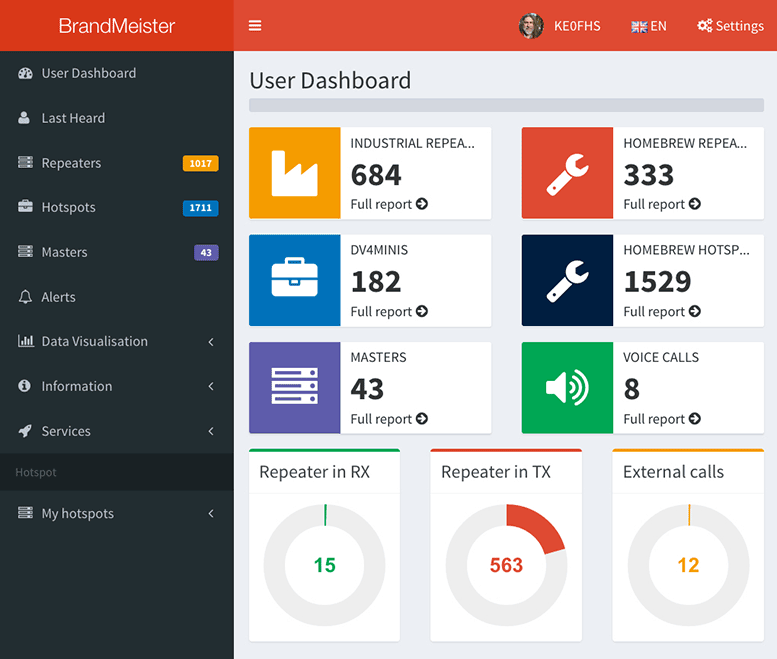
The dashboard also earns my respect for its clean, modern, and fully responsive design, which scales nicely to any size device. It's nice to see an amateur radio-related website that looks like it was coded in this century.
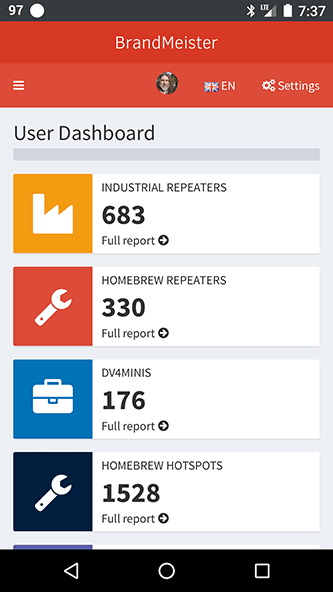
Support the work: A huge shoutout to the BrandMeister Master system admins. They perform this challenging work as a free service to the amateur radio community. Amazing! If you use BrandMeister USA, you can support them by donating a few bucks toward equipment, maintenance, and upkeep:
- U.S. BrandMeister Master 3102: Donate

- U.S. BrandMeister Master 3103: Donate

- International BrandMeister network: Donate

TGIF Network
Another relatively new network is the TGIF network![]() .
.
Regional networks
There also are other, typically regional networks. Here are a few that I know about:
- SkyHub Link System – The Colorado based SkyHub Link
 Repeater Linking System, N2SKY, is an all-mode link system providing a communication bridge between many amateur radio repeaters and networks. The overall purpose of the SkyHubLink System is to provide the following:
Repeater Linking System, N2SKY, is an all-mode link system providing a communication bridge between many amateur radio repeaters and networks. The overall purpose of the SkyHubLink System is to provide the following:
- Enable anyone with any mode radio to essentially contact anyone with any mode radio anytime anywhere.
- To provide repeaters with activity to let other hams know they are there on the air.
- To interconnect different regions with each other for fun and possible emergency use when needed.
- To promote good amateur practice and friendship for all, this is an OPEN system.
- Rocky Mountain Ham Radio – The RMHAM network
 covers Colorado and parts of New Mexico and Wyoming. RMHAM repeaters up and down a large swath of the Rocky Mountain region are linked together making it possible for a large community of hams to communicate on the supported talkgroups.
covers Colorado and parts of New Mexico and Wyoming. RMHAM repeaters up and down a large swath of the Rocky Mountain region are linked together making it possible for a large community of hams to communicate on the supported talkgroups. - Florida Digital Amateur Radio Network – The FDARN_Network
 "was created for medical facilities to stay in contact with each other in an emergency situation. This network was created by and comprised of licensed amateur radio operators. Any licensed amateur may use our system."
"was created for medical facilities to stay in contact with each other in an emergency situation. This network was created by and comprised of licensed amateur radio operators. Any licensed amateur may use our system." - Northern Colorado DMR – NoCO DMR
 is a group of Northern Colorado amateur radio operators who operate and maintain a coordinated amateur radio DMR repeater network in Northern Colorado. It spans from Denver north to Fort Collins and Wellington, and west to Estes Park and Red Feather Lakes, and hosts the NoCO talkgroup, 3171, as well as a Colorado Severe Weather talkgroup, 31083, and a Mountain Front Range talkgroup, 31084.
is a group of Northern Colorado amateur radio operators who operate and maintain a coordinated amateur radio DMR repeater network in Northern Colorado. It spans from Denver north to Fort Collins and Wellington, and west to Estes Park and Red Feather Lakes, and hosts the NoCO talkgroup, 3171, as well as a Colorado Severe Weather talkgroup, 31083, and a Mountain Front Range talkgroup, 31084.
DMR Nets
A good resource for finding DMR nets is the Ham Radio DMR Nets Telegram group. It has a quite comprehensive list of active DMR nets. Each net is displayed an hour before it goes live, making it easy to find out what's currently on the air: https://t.me/HamRadioDMRNets![]()
Telegram groups
There's also a good list of other Amateur Radio Telegram groups that was compiled by Tom, W2XQ, which is posted on the Colorado Digital website's Resources page: Ham Radio Telegram Channels![]() .
.

